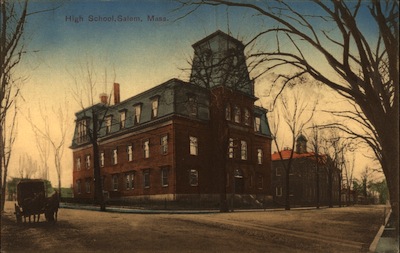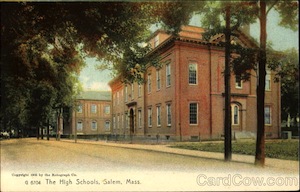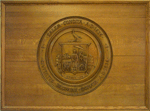Salem schools of the past: Difference between revisions
No edit summary |
No edit summary |
||
| (9 intermediate revisions by the same user not shown) | |||
| Line 4: | Line 4: | ||
(Named after Gen. Henry K. Oliver) | (Named after Gen. Henry K. Oliver) | ||
*Bentley School, Essex St. --- 1861 | *Bentley School, Essex St. --- 1861 | ||
*Epes Grammar School, Aborn St. | |||
*Cogswell School, School St. --1862 (now condominiums) | *Cogswell School, School St. --1862 (now condominiums) | ||
| Line 24: | Line 26: | ||
*Classical and High School, Highland Ave. ---1909 (now Collins Middle School) | *Classical and High School, Highland Ave. ---1909 (now Collins Middle School) | ||
*Saltonstall School, Lafayette St. --- 1916 | *Saltonstall School, Lafayette St. --- 1916 (originally on Holly Street, constructed of wood in 1874. It was originally called | ||
the Browne School and later the Holly Street Grammar School. | |||
*St. Joseph School, Lafayette St. --1925 (Razed in 1982) | *St. Joseph School, Lafayette St. --1925 (Razed in 1982) | ||
| Line 30: | Line 34: | ||
*Endicott School, Boston St. -- 1930 | *Endicott School, Boston St. -- 1930 | ||
*Sheridan School, corner Upham & Orne St. (10 Orne St.) -- 1930 (now condominiums) | *Sheridan School, corner Upham & Orne St. (10 Orne St.) -- dedicated Oct. 16, 1930 (now condominiums) | ||
(Named after Lt. Philip B. Sheridan) | (Named after Lt. Philip B. Sheridan) | ||
| Line 50: | Line 55: | ||
Salem Normal School and Salem High School, Broad Street | Salem Normal School and Salem High School, Broad Street | ||
In the late 1800's, there existed a "schoolhouse" row on Broad Street, just west of Summer St. The city's Classical and High School, Oliver School and Salem Normal School sat side by side | |||
until 1897, when the Normal School moved to its new location at Loring Avenue and Lafayette Street. The future Salem State University had been a presence on Broad Street since it opened in 1854. | |||
Oliver School, just to its west, was named for Henry Kemble Oliver, educator and former mayor of Salem and Lawrence. | |||
Salem Classical and High School had been formed by merging the Latin and High School, English High School and Girls High School in 1856. The Broad Street building was erected at the time to | |||
serve as the main educational building. | |||
In the early 1900's, Salem had five public grammar schools: Bowditch on Flint Street, Phillips on Washington Square South, Pickering on North Street, Saltonstall on Holly Street and Bentley | |||
at 50 Essex Street, near the head of Bentley Street. The original Saltonstall School burned in the Salem Fire of 1914 and would be replaced by the current structure on Lafayette Street. A new, larger | |||
Bentley School would later be built farther east on Essex St. | |||
Primary schools were sprinkled throughout the city. Browne School on Ropes Street near Lafayette Park was probably named for Samuel Browne or his family. Attached to Browne School was Naumkeag | |||
School, which started out in 1869 as a "half-time" school for mostly French-Canadian worker-students at the Naumkeag Mills. The Boston Street area was home to Lincoln School on Fowler Street, A.A. Low | |||
School on Nichols Street near Gallows Hill and Endicott School on Boston Street. | |||
Other primary schools were tucked away on side streets. Prescott was sited on Howard Street, Bertram School on Willow Avenue at the corner of Summit Avenue. North Salem had a pair of primary schools- | |||
Upham on North Street and Pickering on School Street. Derby School on Jefferson Avenue in Castle Hill would soon become the home of St. Anne's School, one of the number of Catholic schools in Salem. | |||
The Lynde Primary School at 15 Hebert Street was adjacent to one of the city's five kindergartens. Another was part of the "model school" at Normal School (later becoming the Horace Mann Lab School). Other | |||
kindergartens were on Bridge Street, Beckford Street and School Street. | |||
The building that now houses Collins Middle School was erected in 1909 and was the new home of Salem High School. Its location, far removed from any of the city's population centers, drew cries of outrage | |||
from parents and taxpayers in general", according to Jim McAllister in his column Essex County Chronicles. | |||
[[Category:Browse Index]] | [[Category:Browse Index]] | ||
| Line 78: | Line 108: | ||
*"By the book: City's first school began in 1637" ''Salem Evening News'', Sept. 1, 1999, p. A3 | *"By the book: City's first school began in 1637" ''Salem Evening News'', Sept. 1, 1999, p. A3 | ||
*"Examining Salem's educational legacy" ''Salem News'', Sept. 10, 2012, p. 7, Jim McAllister (Essex County Chronicles) | |||
*[http://salem.noblenet.org/eg/opac/record/3132996?locg=63 Catalogue of members of the late English High School of Salem, Massachusetts] From 1827-1857 | *[http://salem.noblenet.org/eg/opac/record/3132996?locg=63 Catalogue of members of the late English High School of Salem, Massachusetts] From 1827-1857 | ||
*[https://catalog.noblenet.org/eg/opac/record/1744216?locg=63 Salem, Massachusetts] Turino and Schier, p. 58 (photo of old Bentley School) | |||
Latest revision as of 11:27, 17 March 2021
The following are dates of dedication for Salem's schools of the past:
- Oliver School, Broad St. --- 1818
(Named after Gen. Henry K. Oliver)
- Bentley School, Essex St. --- 1861
- Epes Grammar School, Aborn St.
- Cogswell School, School St. --1862 (now condominiums)
- Bowditch School, 35 Flint St. -- 1870
- Pickman School, School St. ---1872 (now condominiums)
- Juniper School, 25 Cheval Ave. ---1923
- Hacker School, Dean St. (now Flint St.) --1785 (renamed Hacker School in 1850)
- Phillips School, 86 Essex St. --1883
(Named after Stephen C. Phillips, former mayor who donated his salary to a school building fund. Building razed in 1983.)
- Pickering School, 181 North St. --1894 (now condominiums)
- Prescott Primary School, Howard St. ---1872
- Classical and High School, Highland Ave. ---1909 (now Collins Middle School)
- Saltonstall School, Lafayette St. --- 1916 (originally on Holly Street, constructed of wood in 1874. It was originally called
the Browne School and later the Holly Street Grammar School.
- St. Joseph School, Lafayette St. --1925 (Razed in 1982)
- Endicott School, Boston St. -- 1930
- Sheridan School, corner Upham & Orne St. (10 Orne St.) -- dedicated Oct. 16, 1930 (now condominiums)
(Named after Lt. Philip B. Sheridan)
- Vocational High School, 5 Broad St. -- 1938-1953
- Vocational High School, Highland Ave. --1953
- Mack Industrial School, 17 Pickman St. --1906 to the late 1920's
- Prior High Schools: Latin Grammar School -- 1637
- English High School, 1827
- Girl's High School - 1845 : Consolidated into Salem High School 1856
- For entry on closed Catholic Schools, see Catholic Schools on this wiki.
Salem Normal School and Salem High School, Broad Street
In the late 1800's, there existed a "schoolhouse" row on Broad Street, just west of Summer St. The city's Classical and High School, Oliver School and Salem Normal School sat side by side until 1897, when the Normal School moved to its new location at Loring Avenue and Lafayette Street. The future Salem State University had been a presence on Broad Street since it opened in 1854.
Oliver School, just to its west, was named for Henry Kemble Oliver, educator and former mayor of Salem and Lawrence.
Salem Classical and High School had been formed by merging the Latin and High School, English High School and Girls High School in 1856. The Broad Street building was erected at the time to serve as the main educational building.
In the early 1900's, Salem had five public grammar schools: Bowditch on Flint Street, Phillips on Washington Square South, Pickering on North Street, Saltonstall on Holly Street and Bentley at 50 Essex Street, near the head of Bentley Street. The original Saltonstall School burned in the Salem Fire of 1914 and would be replaced by the current structure on Lafayette Street. A new, larger Bentley School would later be built farther east on Essex St.
Primary schools were sprinkled throughout the city. Browne School on Ropes Street near Lafayette Park was probably named for Samuel Browne or his family. Attached to Browne School was Naumkeag School, which started out in 1869 as a "half-time" school for mostly French-Canadian worker-students at the Naumkeag Mills. The Boston Street area was home to Lincoln School on Fowler Street, A.A. Low School on Nichols Street near Gallows Hill and Endicott School on Boston Street.
Other primary schools were tucked away on side streets. Prescott was sited on Howard Street, Bertram School on Willow Avenue at the corner of Summit Avenue. North Salem had a pair of primary schools- Upham on North Street and Pickering on School Street. Derby School on Jefferson Avenue in Castle Hill would soon become the home of St. Anne's School, one of the number of Catholic schools in Salem.
The Lynde Primary School at 15 Hebert Street was adjacent to one of the city's five kindergartens. Another was part of the "model school" at Normal School (later becoming the Horace Mann Lab School). Other kindergartens were on Bridge Street, Beckford Street and School Street.
The building that now houses Collins Middle School was erected in 1909 and was the new home of Salem High School. Its location, far removed from any of the city's population centers, drew cries of outrage from parents and taxpayers in general", according to Jim McAllister in his column Essex County Chronicles.
See Also
- Vertical File in the Salem Collection - Salem Schools (schools of the past folder)
- Postcard image courtesy CardCow.com (State Normal School on corner, High School next bldg.)
- Salem in Vintage Postcards ed. by C. R. Mathias, p. 49-51 (photos of Pickering, Saltonstall, Bowditch, Phillips and (old) Bentley schools)
- Vertical File - Sheridan, Philip B.
- Salem Vocational High School, 5 Broad St. 50th Anniversary Pamphlet
- "Lt. Philip B. Sheridan School Dedicated in Impressive Service"Salem Evening News, Oct. 6 1930, p. 1
- "School days gone by: Phillips School students,faculty hold memory fest" Salem Evening News, June 12, 1998, p. A1
- "Prescott Primary School was named for blind writer" Salem Evening News, Feb. 14, 1929, p.?
- Historical Sketch of Salem by Osgood, p.104-5
- Old Naumkeag by Webber, p.110-1
- Annals of Salem by J. Felt, p.452-463
- "By the book: City's first school began in 1637" Salem Evening News, Sept. 1, 1999, p. A3
- "Examining Salem's educational legacy" Salem News, Sept. 10, 2012, p. 7, Jim McAllister (Essex County Chronicles)
- Salem, Massachusetts Turino and Schier, p. 58 (photo of old Bentley School)


